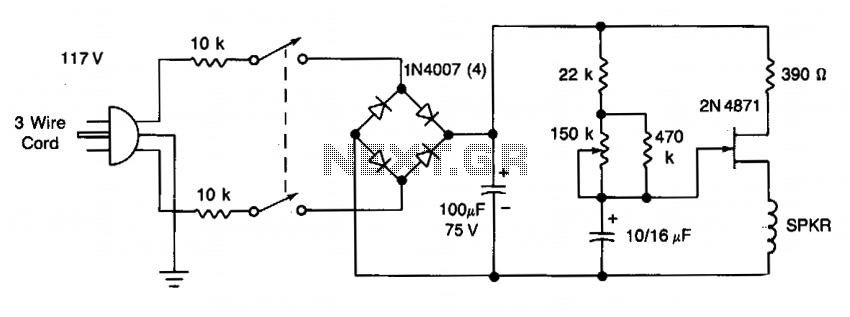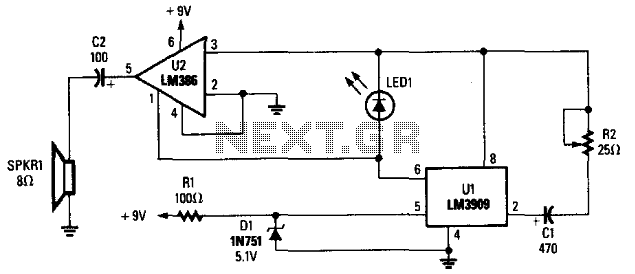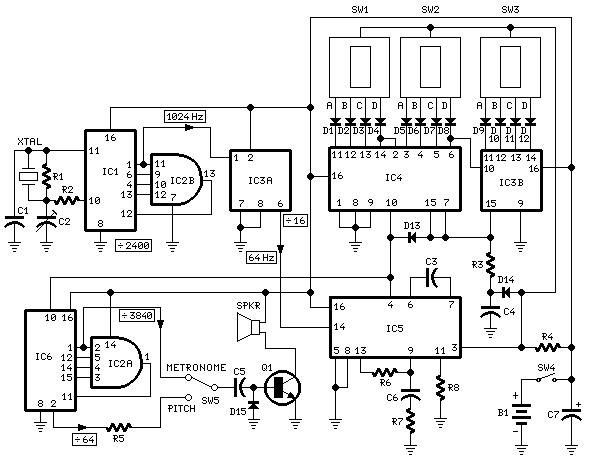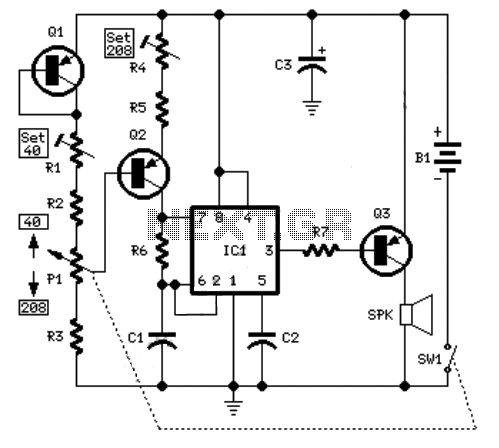
Metronome
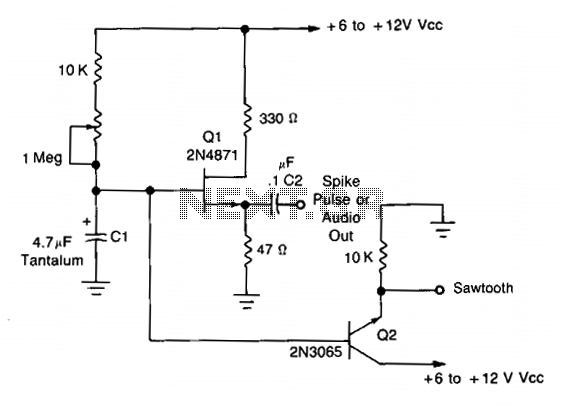
This simple oscillator utilizes a 2N4871 UJT to generate pulses ranging from 0.2 to approximately 20 Hz. A spike can be observed at C2, while a sawtooth waveform is present at the emitter of Q2, measuring about 2-3 V peak-to-peak, contingent upon Vcc.
The oscillator circuit primarily consists of the 2N4871 Unijunction Transistor (UJT), which serves as the core component for pulse generation. The UJT operates by utilizing its unique characteristics, which allow it to switch on and off rapidly, creating the desired oscillation frequency. The frequency of oscillation is determined by the values of the resistors and capacitors connected to the UJT, specifically affecting the timing intervals for charging and discharging.
In this configuration, C2 acts as a coupling capacitor, allowing the spike generated by the UJT to be transmitted to subsequent stages or components in the circuit. The sawtooth waveform observed at the emitter of Q2 is indicative of the charging and discharging cycle of the capacitor connected to the emitter, which results in a linear ramp-up followed by a sharp drop, characteristic of sawtooth signals.
The amplitude of the sawtooth waveform, approximately 2-3 V peak-to-peak, is influenced by the supply voltage (Vcc). As Vcc increases, the peak-to-peak voltage of the sawtooth waveform may also increase, provided the circuit components are rated for the higher voltage levels.
Overall, this oscillator design is suitable for low-frequency applications where simple pulse generation is required, such as in timing circuits, signal modulation, or as a basic waveform generator for testing purposes. The simplicity of the circuit allows for easy implementation and adjustment, making it a valuable tool in various electronic applications.This simple oscillator uses a 2N4871 UJT to give pulses from 0.2 to about 20 Hz. A spike is available at C2, a sawtooth at the emitter of Q2 of about 2-3 V p-p, depending on Vcc. 🔗 External reference
The oscillator circuit primarily consists of the 2N4871 Unijunction Transistor (UJT), which serves as the core component for pulse generation. The UJT operates by utilizing its unique characteristics, which allow it to switch on and off rapidly, creating the desired oscillation frequency. The frequency of oscillation is determined by the values of the resistors and capacitors connected to the UJT, specifically affecting the timing intervals for charging and discharging.
In this configuration, C2 acts as a coupling capacitor, allowing the spike generated by the UJT to be transmitted to subsequent stages or components in the circuit. The sawtooth waveform observed at the emitter of Q2 is indicative of the charging and discharging cycle of the capacitor connected to the emitter, which results in a linear ramp-up followed by a sharp drop, characteristic of sawtooth signals.
The amplitude of the sawtooth waveform, approximately 2-3 V peak-to-peak, is influenced by the supply voltage (Vcc). As Vcc increases, the peak-to-peak voltage of the sawtooth waveform may also increase, provided the circuit components are rated for the higher voltage levels.
Overall, this oscillator design is suitable for low-frequency applications where simple pulse generation is required, such as in timing circuits, signal modulation, or as a basic waveform generator for testing purposes. The simplicity of the circuit allows for easy implementation and adjustment, making it a valuable tool in various electronic applications.This simple oscillator uses a 2N4871 UJT to give pulses from 0.2 to about 20 Hz. A spike is available at C2, a sawtooth at the emitter of Q2 of about 2-3 V p-p, depending on Vcc. 🔗 External reference
